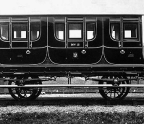
Genesis
One early notion of the Trent Valley Railway (also known as the Manchester to Birmingham Extension) was of a railway running between Stone and Rugby, a distance of 62½ miles. The Bill presented to Parliament was rejected in 1839 owing to the objections of the London & Birmingham Railway.
A second scheme, known as the Stafford & Rugby Railway, was also rejected in the 1841 Session of Parliament and was regarded as a great disappointment to its main promoter Sir Robert Peel. Undaunted, a revised project was presented to Parliament, this time entitled the Trent Valley Railway (TVR).
By 1845 the railway world had changed. Royal Assent was granted on 21st July 1845, with the full support of the London & Birmingham Company, which had hitherto attempted to bribe the Trent Valley promoters with the sum of £20,000, but now offered to subscribe £277,780 towards construction. Two other companies also subscribed a similar amount: the Grand Junction Railway and the Manchester & Birmingham Railway.
The support of these three companies led to amalgamation, leading to the formation of the London & North Western Railway, the Act of Incorporation falling on 16th July 1846, by which time the Trent Valley contractors had commenced work. The ceremony of turning the first sod occurred on 13th November 1845, carried out by Sir Robert Peel in a field (Camel Close) in Tamworth.
A report on the imminent ceremony appeared in the Sheffield and Rotherham Independent, 8th November 1845. “We noticed lately, the spade made by Mr. Maleham of Westbar, for the use of Sir Robert Peel in turning the first sod of the Trent Valley Railway. In consequence of Sir Robert’s attack of gout the ceremony has been deferred, and it is now fixed for the 11th inst. This has given time for the completion of the embellishments on the spade, which was returned to the manufacturer for the purpose. On the front of the blade are Sir Robert Peel’s arms, with the following inscription: ‘The works of the Trent Valley Railway from Stafford to Rugby were commenced on the 11th day of November 1845, on which occasion the first sod was turned by the Rt. Honourable Sir Robert Peel, Baronet, MP, upon lands in the Parish of Tamworth, and county of Stafford’.”
A description of the line
A vivid description of the line filled many column inches in The Standard, 21st September 1846, whose reporters travelled the line. From the description of the on-going work, and the engineering features of note, we can highlight several aspects of the 49½-mile-long railway.
Full approbation was laid upon the accomplishments of the contractors, Messrs. MacKenizie, Stephenson and Brassey whose organisation of men and materials expedited swift progress. No less approbation was awarded to Thomas Gooch and other resident engineers.
As the reporters passed over the line they witnessed “the active operations in the heavy cuttings at Brinklow, Coombe Fields, and Shilton, between Rugby and Nuneaton, from each of which 40,000 cubic yards of earth are moved weekly”. Also, they could not fail to notice “the taste displayed in arches, viaducts, and bridges”. The bridge over the River Avon, which consisted of seven arches, “gives promise of being a beautiful structure”. The viaduct near Brinklow was fast approaching completion, whilst the viaducts over the River Anker at Polesworth (“built of bricks, with stone dressings”) exemplified the combination of skill and force of the workmen.
“Over the River




